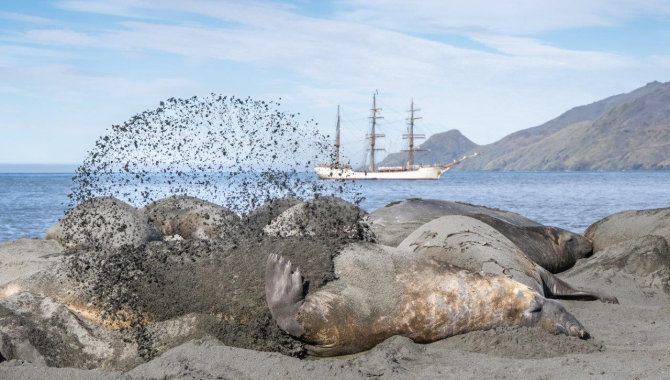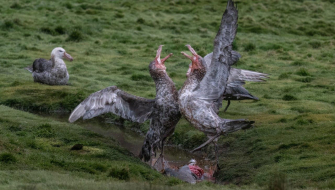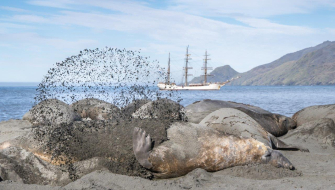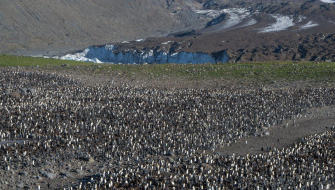Ocean Harbour and St. Andrews Bay

A wonderful night, quiet, windless and starry. Sometimes, it also happens that South Georgia is like this, and what a better place than Ocean Harbour to enjoy the darkness, the calm waters and the hauling of the hundreds, if not thousands, of Fur seals that live here. But they cannot out-loud the Elephant seal thunderous growls.
This sheltered harbour also played a role during the golden age of whaling. A whaling station stood there at the head of the bay until 1920 when most of it was moved to Stromness. Only few visible relics remained standing testament of those times long gone. Among them old machinery, winches, cables, pipes and rusty chains of all sizes, a shed and a few graves. Actually, the earliest recorded grave in South Georgia had been located around here from Frank Cabrail, a steward who died on 14th October 1820 onboard the sealer Francia Allen.
Most noticeable and one of the highlights of this harbour is of course the shipwrecked Bayard. Thus the zodiac shuttling to the shore included a little cruise around her rusty hull. She heels a little on port side with one of her three masts collapsed and with the deck overgrown by vegetation, now home for a number of nesting shags and terns. The corroded hull of the Bayard contrasts against the green vegetation in the background as well as to the blue water. Floating around her, the canopy of the Giant kelp forest that grows all over the embayment.
Originally ship-rigged, she was converted into a bark in 1882. Although EUROPA and Bayard share many similarities, Bayard is made out of iron instead of our steel hull, but she is also hand riveted.
She is larger than EUROPA, with her 67 meters in length and beam of 11.1 meters. There on the rocks close to shore she towers over our heads when we approach her, both from the water and from land.
She was originally owned by Hall Line company. The builder was T. Vernon and Son from Liverpool who finished the ship in 1864. After an agitated history, calling in many ports from the UK to Canada and as far as Suva in Fiji islands and Calcutta, after an iceberg collision from which she suffered quite a large damage, she was sent here to finish her life as a coaling hulk in 1911. Originally the ship was moored at the pier on the north side of the bay, but during a storm on June 6th 1911, she broke free and ran aground on the opposite side of the bay. There she lays since, giving to any visitors who enters the bay an example of an early iron ship. 1911, the same year EUROPA was launched, this is the sort of connection we have with this seldom visited though beautiful corner in South Georgia.

The beach at the end of the bay is where we headed after having a good look at the wreck. Behind the beach a flat area covered by lush green grass filled with large number of scattered rusty relics, invaded by an army of furs seals. There in the middle of all of it stands the shed that we visited and had a look inside. Walking around, we soon spotted a few Giant petrels running around with bloody faces, indicating they probably were feeding on something and sure enough, not too far from the shed we found a few of them feeding on a seal carcass lying in a small water stream. From closeby we quietly observed their feeding habits, interactions and fights trying to secure the best part of the feast for themselves.
Leaving them behind we continued to walk along the beach. There, in the water, on the sand and also amongst the tussock grass a few young Elephant seals found a place for some rest. Carefully walking on the beach and threading in between the tussock we came closer and observed them from a safe distance. From there we continued with a little hike up the sunlit grassy slope up to the ridge from where we could admire the beauty of the harbour, a bay with a number: 1911 for both Bayard and ourselves. And when the sun peaked from behind the clouds we could observe all the colours of the bay coming alive. The blue of the water, orange of the wreck, purple of the kelp and green of the grass, all together they created a palette that engraved this beautiful view in our minds. We continued the walk on the ridge and started our way downhill alongside a water stream that carved a little canyon to the grassy slope. It didn't take too long before we reached our landing site and called for zodiacs.
We are leaving the calm waters of Ocean Harbour and motoring to our next exciting location. Swell is moving the ship around, but not far ahead lies our destination. St. Andrews Bay and the largest king penguin colony on the island and perhaps in the world.
The sun shines over the wide open St. Andrews Bay. Swell breaks all along the length of its sandy beach and the Mounts King, Vogel Peak, Smoky Wall, Mounts Patterson and Skittle (all part of the large Allardyce mountain Range) provide a dramatic set for the area. At their foot, extensive flats left behind after the retreat of the glaciers Cook, Heaney and Buxton.
Large levelled zones and a surfing beach, preferred habitat for the King penguins. And here, in St. Andrews nowadays we can find about 200.000 pairs of them.
But as incredible as it seems, it hasn’t always been like that. For instance during the International Polar Year of 1882-83, scientists counted about 1100 pairs. In 1925 the colony had grown to 32.000 pairs. 60 years later their numbers had grown to 150.000 couples, and increasing as the years pass by.

Leaving them behind we continued to walk along the beach. There, in the water, on the sand and also amongst the tussock grass a few young Elephant seals found a place for some rest. Carefully walking on the beach and threading in between the tussock we came closer and observed them from a safe distance. From there we continued with a little hike up the sunlit grassy slope up to the ridge from where we could admire the beauty of the harbour, a bay with a number: 1911 for both Bayard and ourselves. And when the sun peaked from behind the clouds we could observe all the colours of the bay coming alive. The blue of the water, orange of the wreck, purple of the kelp and green of the grass, all together they created a palette that engraved this beautiful view in our minds. We continued the walk on the ridge and started our way downhill alongside a water stream that carved a little canyon to the grassy slope. It didn't take too long before we reached our landing site and called for zodiacs.
We are leaving the calm waters of Ocean Harbour and motoring to our next exciting location. Swell is moving the ship around, but not far ahead lies our destination. St. Andrews Bay and the largest king penguin colony on the island and perhaps in the world.
The sun shines over the wide open St. Andrews Bay. Swell breaks all along the length of its sandy beach and the Mounts King, Vogel Peak, Smoky Wall, Mounts Patterson and Skittle (all part of the large Allardyce mountain Range) provide a dramatic set for the area. At their foot, extensive flats left behind after the retreat of the glaciers Cook, Heaney and Buxton.
Large levelled zones and a surfing beach, preferred habitat for the King penguins. And here, in St. Andrews nowadays we can find about 200.000 pairs of them.
But as incredible as it seems, it hasn’t always been like that. For instance during the International Polar Year of 1882-83, scientists counted about 1100 pairs. In 1925 the colony had grown to 32.000 pairs. 60 years later their numbers had grown to 150.000 couples, and increasing as the years pass by.

No doubt they are the main character here, but on the north corner of the vast beach, a group of large male Elephant seals pile and moult together. Quite a sight for all of us, it is the first time in the voyage that we actually can properly see these huge animals closeby. So far we just came across youngsters and some females. With their massive body weight up to 3 or even 4 tonnes when they are at their fullest at the beginning of their breeding season, they are the largest seal species in the world the world.
But still, penguins and elephant seals are not on their own here. Countless Fur seals are all over.

The route from the northern side of the bay to the hills overlooking the main penguin rookery would be an easy stroll if it is not for the meltwater stream from the glaciers higher up the mountains, that cuts through the flats. Today it flows with quite a lot of water and strong current.
If we want to have a look at the rest of the site we will have to call the zodiacs and do another exciting stern-landing at the other side of the river mouth. So be it, there we go again to deal with even a larger surge at the beach. St. Andrews, a site teeming with wildlife but very often not the easiest one for disembarkation.
Now, once all safe ashore again, we feel privileged to have the chance to complete our visit.
A short walk over easy terrain lets up to a small ridge that offers the best viewpoints over the whole of the main rookery. A breathtaking scenery. Better to remain in silence for a while, and become accustomed to the sheer scale of the sight on the dimming light of the late afternoon.
